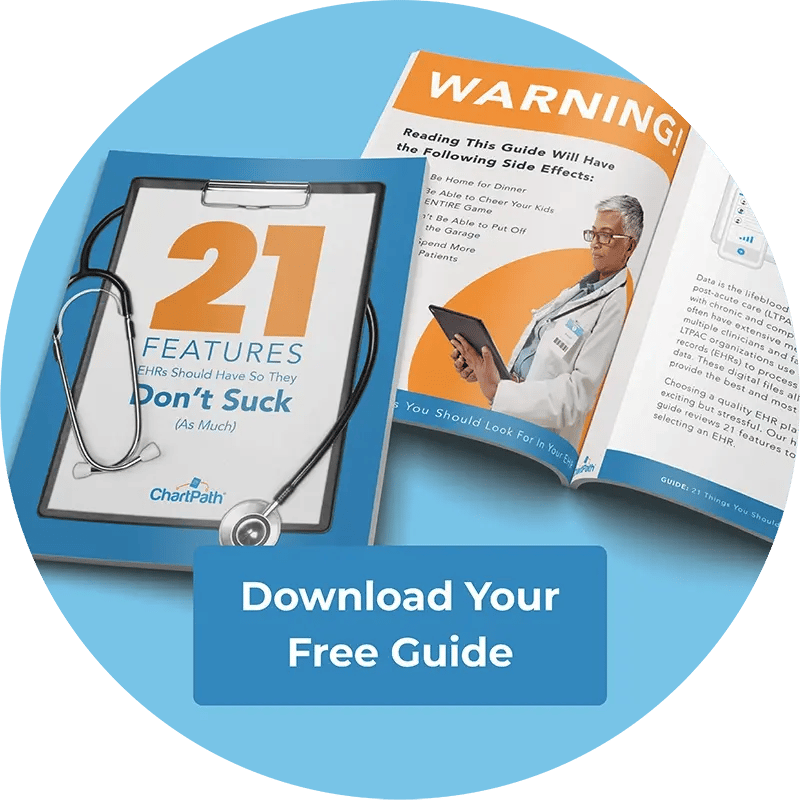Battling Physician Burnout: Smart Strategies for LTPAC Providers

Many healthcare workers enter the field with a desire to help people. Diagnosing and treating disease and other ailments can be rewarding, particularly when they successfully mend a patient and send them back to their everyday life. However, this field is also stressful.
The healthcare field also comes with a myriad of additional stressors, including high-volume workloads, poor work-life balances, and a lack of autonomy for employees. All of these factors lead to physicians eventually burning out. Physician burnout rates reached critical levels in 2021 because of pandemic-related stressors. Although they are falling, the rate was still 45% in 2024.
As a healthcare provider, it's crucial to prioritize the health and wellness of your healthcare professionals, as well as the patients they treat. This blog will explore strategies for combatting burnout, such as a technology-driven efficiency, optimized workflows, and after-hours support through partners like Third Eye Health.
Understanding Burnout in LTPAC
Caregivers in long-term post-acute care (LTPAC) are prone to the same stressors as physicians in other healthcare sectors, including high administrative overload, staffing shortages, and poor work-life balances. With the aging population, many healthcare workers are also taking on caregiving responsibilities in their personal lives.
When physicians begin burning out, they feel drained and overwhelmed, which can impact how they care for patients. They may also start feeling cynical and passing this attitude to coworkers and patients. As a result, it's important to address burnout before it starts to impact your facility.
The Role of Technology in Reducing Physician Stress
Excessive administrative duties are one of the top contributors to physician burnout. Physicians spend an average of 7.9 hours per week on administrative tasks. Reducing this burden gives physicians more time with their patients, which in turn boosts physician morale.
User-friendly electronic health record (EHR) systems, such as those offered by ChartPath, streamline patient documentation procedures. Your physicians can efficiently pull up full patient charts, complete with notes, information on medications, test results, and more. They spend less time charting and more time interacting with their patients and at home.
EHR systems can be integrated with other tools to further streamline physician workflows. For example, integrated revenue cycle management (RCM) services reduce the time physicians spend on financial and billing issues, and AI and automation reduce repetitive tasks. These tools also help your administrative team reduce claim errors so you can get paid faster.
Optimizing Clinical Workflows
Long-term post-acute care often involves working with complex cases. Your patients may have multiple co-morbidities, or they may need a team of specialists to help them recover fully. Coordinating care for these patients requires effective communication between departments and, often, medical institutions.
Specialized EHR solutions for burnout with customizable templates help your physicians accurately capture and analyze patient notes. They can use these templates to monitor relevant information based on their specialty and the patient’s needs. This streamlines the clinical workflow by ensuring that valuable patient information is always in the same place, making it easier for the care team to make informed decisions about their care.
Using EHR solutions that are compatible with skilled nursing facility (SNF) and assisted living facility (ALF) platforms helps eliminate duplicate work while making patient referrals and transfers seamless.
Efficient documentation in healthcare improves patient care. Interoperable EHR solutions give care teams a complete view of their patients' health from the initial incident to discharge. For example, if you’re transferring a patient from your facility to an assisted living facility, the patient’s new care team has a complete record of treatments, including medications, wound monitoring, and complications.
Caregivers don’t need to run duplicate tests or ask patients the same questions they answered during intake. Instead, they can develop a unique care plan based on the patient’s needs and improve their chances of a successful outcome.
After-Hours Support: Leveraging Third-Eye Health
Long hours and heavy workloads are key contributors to physician burnout in LTPAC. In other industries, people can clock out at 5 p.m. and not worry about work until they return the next day. Because LTPAC deals with complex patient cases, your physicians may be called back in the middle of the night to manage patient complications.
Our partner, Third Eye Health, helps alleviate the pressure and gives your physicians a much-needed break without compromising patient care. Third Eye Health’s team of board-certified physicians offer post-acute expertise and after-hours coverage on nights, weekends, and holidays through LTPAC telemedicine solutions.
This team uses a mix of tele-health and onsite care to supplement your physicians when they’re not available. If your patient has an after-hours healthcare need, they can reach a highly skilled physician from the comfort of their bed through a tele-health appointment. Third Eye Health will even dispatch a highly-skilled physician to your facility if a patient needs on-site care.
Partnering with a company that specializes in after-hours physician coverage will allow you to give your team the work-life balance they need to avoid burnout without compromising quality of care.
Creating a Sustainable Work-Life Balance
Speaking of work-life balance, there are other steps you can take to encourage your caregiving team to relax and recharge. Encourage a team-based approach to healthcare. Use your team to distribute patient workloads and spread the sense of responsibility.
With EHR solutions that provide real-time notes and patient insights, anyone on your team can tap into a patient case and support a physician in need of a break. Your team can also actively engage the patients and invite them to participate in their own care, which reduces long-term care provider stress.
Use EHR systems and other data for a realistic caseload assessment for each physician. Estimate patient complexity, appointment type and duration, demographics, administrative load, and other factors to make sure each physician can handle their daily responsibilities.
Get Started on Your Path to Happier Physicians
You can leverage technology to reduce physician burnout in your LTPAC. Start by choosing a specialized EHR solution made for LTPAC to streamline charting and reporting. Use software with interoperability capabilities to easily collect and share patient data for faster intake and transfer.
Encourage your team to work together so one person isn’t shouldering the stress for a group of patients, and supplement your team with after-hours telemedicine support. Create a culture of collaboration and downtime so your team can recharge.
The right technology can make all the difference in your staff’s morale. Contact ChartPath today to learn how we can help.
Blog Post Tags
EHRGet Awesome Content Delivered Straight to Your Inbox!
Posts by topic
- EHR
- Better Charting
- LTPAC
- AI
- RCM
- Compliance
- Healthcare Trends
- Press Release
- GUIDE
- reporting
- Artificial Intelligence
- Assisted Living
- Automation
- Behavioral Health
- Business
- Events
- General
- MIPS
- Operations
- Patient Outcomes
- Physician Billing Services
- Population Health Management
- Resumption of Care
- SNF
- TCM
- Value Based Care
- eCR
- interoperability
- partners
- regulations
- regulatory See All See Less




